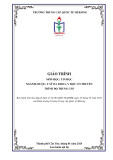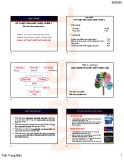
138 Hoa Binh University Journal of Science and Technology - No 14 - 12.2024
PHARMACEUTICALS
DEVELOPMENT AND VALIDATION OF AN ASSAY METHOD FOR
MAGNESIUM IN SOFT CAPSULES BY AAS
Dr. Le Thi Huong Hoa1, MA. Tran Duc Lai2
1Hoa Binh University
2International Institute of Drug Quality Control
Corresponding Author: lthhoa@daihochoabinh.edu.vn
Received: 05/12/2024
Accepted: 16/12/2024
Published: 24/12/2024
Abstract
A procedure for quantitative analysis of trace element magnesium (Mg) in soft capsules (mainly
containing vitamins, trace elements and herbal extracts) using atomic absorption spectroscopy
(AAS) has been established.
The sample was treated to convert the Mg compound to Mg+2 ion form in solution by heating
the sample on a boiling water bath with 10% hydrochloric acid solution, with the addition of
Polysorbate 80. The sample was diluted with 1% hydrochloric acid solution, with the addition of
LaCl3 in the final solution for AAS measurement. The standard solutions were prepared by diluting
the 1000 µg/ml magnesium stock standard solution with 1% hydrochloric acid solution. Using an
atomic absorption spectrometer equipped with a Magnesium hollow cathode lamp and an acetylene-
air flame, measure the atomic absorption of the standard and test solutions at the maximum spectral
line of Magnesium at 285.2 nm. Calculate the results using the standard curve method.
The method validation results showed that the method has high specificity, linear range from 0.1
µg/ml to 0.5 µg/ml with correlation coefficient R2 = 0.9972, high accuracy (from 99.19 -101.39%),
good repeatability with small CV% values (0.44 to 0.91%), the method's determination range is
from 0.18 to 0.32 µg/ml.
Keywords: Soft capsules, Magnesium quantification in soft capsules, Mg quantification, AAS-Mg.
Xây dựng phương pháp định lượng Magnesi trong viên nang mềm bằng quang phổ hấp thụ
nguyên tử (AAS)
TS. Lê Thị Hường Hoa1, ThS. Trần Đức Lai2
1Trường Đại học Hòa Bình
2Viện Kiểm nghiệm thuốc Trung ương
Tác giả liên hệ: lthhoa@daihochoabinh.edu.vn
Tóm tắt
Một quy trình phân tích định lượng nguyên tố vi lượng Mg trong viên nang mềm bằng phương
pháp quang phổ hấp thụ nguyên tử AAS đã được thiết lập.
Xử lý mẫu để chuyển hợp chất của Mg về dạng ion Mg+2 trong dung dịch bằng cách đun trên
cách thủy sôi mẫu thử đã được thêm dung dịch acid hydrochloric 10% và chất Polysorbat 80. Pha
loãng mẫu bằng dung dịch acid hydrochloric 1%, có thêm chất LaCl3 ở dung dịch cuối để đo AAS.
Các dung dịch chuẩn được chuẩn bị bằng cách pha loãng dung dịch chuẩn gốc magnesi 1000 µg/
ml với dung dịch acid hydrochloric 1%. Sử dụng máy quang phổ hấp thụ nguyên tử có trang bị đèn
cathod rỗng Magnesi, đầu đốt sử dụng ngọn lửa acetylene - không khí nén. Tiến hành đo độ hấp thụ
nguyên tử của các dung dịch chuẩn và dung dịch thử tại vạch phổ cực đại của Magnesi 285,2 nm.

No 14 - 12.2024 - Hoa Binh University Journal of Science and Technology 139
PHARMACEUTICALS
Tính kết quả theo phương pháp đường chuẩn.
Kết quả thẩm định phương pháp cho thấy, phương pháp có độ đặc hiệu cao, khoảng tuyến tính
từ 0.1 µg/ml đến 0.5 µg/ml với hệ số tương quan R2 = 0,9972, có độ đúng cao (từ 99,19 -101,39%),
độ lặp lại tốt với các giá trị CV% nhỏ (0,44 to 0,91%), khoảng xác định của phương pháp là từ 0,18
đến 0,32 µg/ml.
Từ khóa: Nang mềm, định lượng Magnesi trong viên nang mềm, định lượng Mg, quang phổ hấp thụ
nguyên tử - Mg.
1. Problem Statement
In recent years, pharmaceutical manufacturers
have tended to produce products containing many
active ingredients to enhance the effectiveness of
the preparation and to be convenient and suitable
for the needs of users. Tablets containing many
ingredients, especially tablets containing vitamins
and trace elements, extracts from medicinal
herbs have been researched and produced quite
abundantly, soft capsules are also one of these
dosage forms. In order to standardize and control
the quality of the above dosage forms, analytical
methods need to be studied and applied to check
the presence and content of active ingredients
in the mixed tablets. Magnesium in the form of
glucolate or chloride salt is one of the minerals
commonly found in tablets containing vitamin
and trace element mixtures. Magnesium is an
essential mineral, playing an important role in
the human body, is a coordinating factor in about
250-300 enzyme systems that regulate the body's
biochemical processes. Magnesium is necessary
for the metabolism of calcium, phosphorus,
sodium, potassium, vitamins B, C... regulating the
absorption, use and excretion of these substances.
Helps bones and teeth stay healthy, prevents
calcium deposits that cause kidney stones,
reduces indigestion and constipation. Magnesium
regulates the nervous system and motor function
of the muscular system... [1]. In this article, we
would like to introduce the results of a study on
the method of quantifying magnesium (Mg) in
the form of magnesium glucolate in soft capsules
using atomic absorption spectroscopy (AAS).
2. Materials and Research Methods
Chemicals and Standards: Pure type
used for AAS measurement (Ion-exchange
water with resistivity ≥18 MΩ.cm. Merck's
polysorbate 80, polysorbate solution: Dissolve
100 ml of polysorbate 80 in 1000 ml of
absolute ethanol. Hydrochloric acid: Merck's
ultra-pure type, hydrochloric acid solution in
ion-exchange water with concentrations: 1%
and 10% (v/v); Lanthan chloride (Merck),
Lanthan chloride 2.7% solution: Dissolve 2.7
g of Lanthan chloride in 1% hydrochloric acid
solution to 100 ml
Magnesium stock standard solution with
concentration of 1000 mg/L, SKS: HC 258003
(Merck)
Research Subjects
Samples: Blank sample: Pipet 10 ml of
2.7% Lanthan chloride solution into a 100 ml
volumetric flask, add 1% hydrochloric acid
solution to the mark, shake well. Standard
sample: From the original Magnesium
standard solution with a concentration of
1000 µg/ml, dilute with 1% hydrochloric acid
solution to obtain solutions with appropriate
concentrations. Test sample: Amorvita ginseng
soft capsule enteric solution. Placebo sample:
Amorvita ginseng soft capsule enteric solution
but without magnesium compounds. Self-
made sample: Add Mg standard solution to
Placebo sample (used in the method's accuracy
verification).
Equipment and Instruments: Calibrated
according to ISO/IEC 17025
Thermo scientific iCE 3500 atomic
absorption spectrometer; SARTORIUS ED224S
analytical balance, accuracy 0.1 mg; Argon gas
cylinder; Water bath, Volumetric flask, beaker
made of type A glass, Micropipette 10-100 µl;
100-1000 µl …

140 Hoa Binh University Journal of Science and Technology - No 14 - 12.2024
PHARMACEUTICALS
Research Method
Analysis Process Building
Sample treatment: Add a certain amount of
10% hydrochloric acid solution to the sample,
add Polysorbate 80 surfactant, stir well to
increase the acid's ability to contact with the
sample. Heat the mixture in a water bath, the
sample digestion time is faster. Then, dilute
the sample with 1% hydrochloric acid solution
to a suitable concentration, add 2.7% LaCl3
solution to the final solution to measure AAS.
Procedure: Using an atomic absorption
spectrometer equipped with a Magnesium
hollow cathode lamp, the burner uses an
acetylene-compressed air flame. Measure the
atomic absorption of standard solutions and
test solutions at the maximum spectral line
of Magnesium 285.2 nm [2], [5], [6]. The
appropriate measurement parameters and
methods will be investigated and selected.
Evaluation of Analytical Procedures:
Based on reference to documents of ICH [7],
USP [8], AOAC [4], Circular No. 32/2018/
TT-BYT dated November 12, 2018 of the
Ministry of Health regulating the registration
of drugs and pharmaceutical ingredients
[3], The evaluated indicators: Specificity;
Linearity; Accuracy; Precision; Method
determination range.
Data processing method: By statistical
method.
3. Results and Discussion
Development of Analysis Procedure
AAS measurement parameters: Through
field survey, combining default parameters of
the device, machine parameters and optimal
measurement temperature program are
presented in Table 1.
Fig7. Effect of excipients to create NR3 on the viability and death of HL-6
Sample preparation: To select the
appropriate hydrochloric acid concentration,
we mixed HCl solutions with different
concentrations (5%; 10% and 20%) and kept the
other components the same, then surveyed the
recovery ability of Mg in the sample matrix. The
results showed that: At 5% acid concentration,
the amount of Mg recovered was not complete,
while at 10% and 20% concentrations, the
amount of Mg recovered was from 99.0 to
101.0%, we chose 10% hydrochloric acid
solution. With a similar survey, we found that
using 0.5 ml of Polysorbate solution for a 0.25 g
sample was appropriate.
Prepare Standard Solution: Dilute the 1000
µg/ml Magnesium stock standard solution with
1% hydrochloric acid solution to obtain a standard
solution with a Magnesium concentration of 10 µg/
ml. In 4 100 ml volumetric flasks, add 1 ml, 2 ml, 3
ml, 4 ml of 10 µg/ml Magnesium solution to each
flask, add 10 ml of 2.7% Lanthan chloride solution,
then add 1% hydrochloric acid solution to the
mark, shake well. The obtained standard solutions
have Magnesium concentrations of 0.1 µg/ml; 0.2
µg/ml; 0.3 µg/ml and 0.4 µg/ml, respectively.
Test Sample Preparation: Take 20 soft
capsules, determine the average mass of the drug
in the capsule, mix well. Weigh accurately about
0.25 g of the drug into a 100 ml volumetric flask.
Add 10 ml of 10% hydrochloric acid solution,
0.5 ml of Polysorbate solution to the flask, heat
on a boiling water bath, shake occasionally until
completely dissolved, heat for another 15 minutes,
let cool, add ion exchange water to the mark, shake
well to get solution A. Pipette exactly 10.0 ml of
solution A into a 100 ml volumetric flask, add 1%

No 14 - 12.2024 - Hoa Binh University Journal of Science and Technology 141
PHARMACEUTICALS
hydrochloric acid solution to the mark, shake well
to get solution B. Pipette exactly 1.0 ml of solution
B into a 50 ml volumetric flask, add 5 ml of 2.7%
LaCl3 solution, add 1% hydrochloric acid solution
to the mark, shake well.
Blank sample: Pipet 10 ml of 2.7% Lanthan
chloride solution into a 100 ml volumetric flask,
add 1% hydrochloric acid solution to the mark,
shake well.
Procedure: Measure the atomic absorption
of the blank sample solution, standard solution
and test solution at the maximum spectral line of
Magnesium 285.2 nm. From the absorbance of
the standard solutions, establish an experimental
standard curve showing the dependence of
absorbance on Magnesium concentration and
calculate the Magnesium concentration in the test
solution based on the standard curve.
Magnesium content (%) compared to label is
calculated according to the formula:
100*
80,39*
*
*
1000
(%)
t
tb
m
MDC
X=
In which:
C (µg/ml): Magnesium concentration of the test
solution measured on the machine.
mt (g): mass of the drug to be quantified.
Mtb (g): Average mass of the drug in the capsule.
D: Dilution factor of the test solution.
39.8: Theoretical Mg content in 1 capsule.
Evaluation of the Magnesium Analysis Process in
the Sample
Method Specificity: Evaluate the influence of the
sample matrix on the measurement results.
- Blank sample: Prepare as stated in the section on
developing the analytical procedure.
- Test sample: Weigh accurately about 0.25 g of the
preparation into a 100 ml volumetric flask, process
the sample as stated above. The test solution has a
Magnesium concentration of about 0.2 µg/ml.
- Placebo sample: Weigh a 0.25 g placebo sample
without Magnesium into a 100 ml volumetric flask,
add the reagents, and process as the test sample
stated above.
The actual sample weight is shown in Table 2.
Table 2. Actual Sample Weight
Magnesium standard solution 0.2 µg/ml: Is a
Magnesium standard solution with a concentration
of 0.2 µg/ml in the linear range survey.
Measure the absorbance of blank, placebo,
test samples and standard solutions under the
stated conditions. The results showed that blank,
Placebo gave negligible absorbance (< 2% of
the absorbance of Magnesium at the measured
concentration), standard and test gave absorbance
greater than 0.2 at the characteristic wavelength
of Magnesium 285.2 nm, as shown in Table 3,
Figure 1.
Table 3. Results of the Study on the Influence of Sample Matrix Solution

142 Hoa Binh University Journal of Science and Technology - No 14 - 12.2024
PHARMACEUTICALS
Figure 1. Absorbance of Magnesium at 285.2 nm: (1): blank solution; (2): Placebo solution; (3):
0.2µg/ml Magnesium standard solution; (4): sample solution.
Table 4. Preparation of Standard Series Solutions
Table 5. Results of Linear Range Survey of the Method
Linear Range
Dilute the 1000 µg/ml Magnesium
standard stock solution with 1% hydrochloric
acid solution to obtain a 10 µg/ml Magnesium
standard solution. From this standard solution,
continue diluting as shown in Table 4 to obtain
the Magnesium standard series solutions.
Measure AAS of standard series solutions
under the stated conditions, the results are
shown in Table 5 and Figure 2.












![Bài giảng Vi sinh vật: Đại cương về miễn dịch và ứng dụng [chuẩn nhất]](https://cdn.tailieu.vn/images/document/thumbnail/2025/20251124/royalnguyen223@gmail.com/135x160/49791764038504.jpg)













